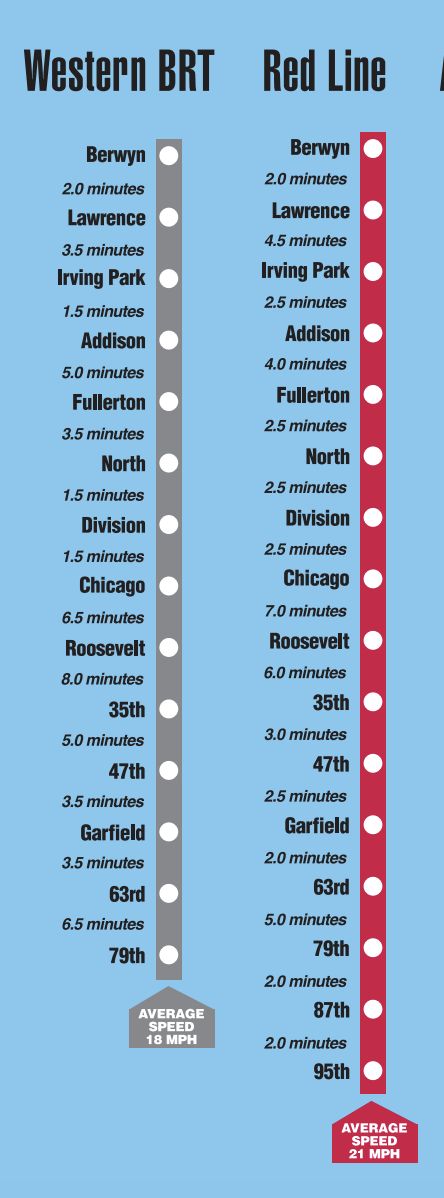
This past week, Ald. Vasquez and Ald. Matt Martin co-wrote a letter to Mayor Johnson, CTA President Dorval Carter, and CDOT Commissioner Tom Carney calling for Bus Rapid Transit on Western Avenue. The letter, which was co-signed by 17 out of 18 Alders with Wards intersecting Western Ave, was sent on Wednesday, May 22nd. See the text of the letter below (for the full version, including signatures and footnotes, see the PDF below the text).
Re: Bus Rapid Transit on Western Avenue
Dear Mayor Johnson, President Carter, and Commissioner Carney,
We are writing to respectfully request that the Department of Transportation (CDOT) and the Chicago Transit Authority (CTA) take the necessary steps to implement Bus Rapid Transit (BRT) on Western Ave. Doing so will help improve access to housing, jobs, and education for thousands of Chicagoans and is supported by five recently released studies and recommendations published by Mayor Johnson’s Transition Committee, the CTA, CDOT, the Chicago Metropolitan Agency for Planning (CMAP), the Regional Transportation Authority (RTA), and the Department of Planning and Development (DPD). To that end, we ask that the CTA include Western Ave among the potential BRT corridors to study through their recent Invest in Cook grant, with the goal of rapidly applying for federal funds to execute on this project.
As the longest continuous street in the city, Western Ave is uniquely situated to create an equitable transit-oriented corridor, thanks to its rapidly rising bus ridership, its connection with a variety of mass transit lines, and Chicago’s explicit focus on increasing its residential density and affordability. With four different bus lines (CTA’s #49, #X49, and #49B and Pace’s #349), Western Ave typically ranks in the top five highest ridership corridors in the city, averaging around 22,000 daily riders. And these numbers continue to increase, with ridership in post-pandemic years outpacing the CTA system’s recovery as a whole by ten percentage points.
The CTA’s Better Streets For Buses Plan identified Western Ave as one of the Authority’s Bus Improvement Corridors, due to the high number of riders who transfer from the Western bus to the Metra. Indeed, Western Ave connects to Metra’s MD-N, MD-W, NCS and BNSF lines, in addition to five different CTA El stations. These connections are vital, as Western Ave runs though many communities with no direct access to rail service, from Chicago Lawn and Gage Park to Ukrainian Village and West Ridge.
As the population along the Western Ave corridor continues to grow, transit will be central to sustaining and supporting that growth. The Department of Planning and Development’s 2022 Western Avenue Corridor Study identified better bus service as a common request from community members and highlighted it as central to support dense, affordable housing and a thriving commercial corridor. Moreover, as a major transportation artery, Western Ave faces significant traffic congestion, especially during rush hour. A major impact of this has been slowing transit operations—over the last 20 years, average bus speeds have slowed by 9% on the CTA , and CMAP recently opined that “improving bus speed and reliability will enable CTA and Pace to operate service more efficiently, allowing for more service at the same cost.” Eliminating car trips by shifting riders to transit will help reduce congestion, as well as improving air quality and decreasing wear on our street infrastructure.
Implementing BRT will help speed up buses in ways that enhance equity across our city. Over 95% of Chicagoans live near a bus stop, as compared to just 30% for rail. Low-income residents and communities of color have a higher reliance on transit, with buses making up a much higher share of transit trips for households making less than $35,000 than for any other income group. Both during and after the pandemic, CTA and Pace Bus lines have retained more riders than rail in the Chicago region, indicating that bus service is heavily relied upon by essential workers.
In addition to government agencies and elected officials, support for BRT has been embraced by many advocacy groups, including Active Transportation Alliance, Better Streets Chicago, Commuters Take Action, and Sierra Club. During CDOT and CTA’s community engagement as part of their recent Better Streets for Buses planning process, Western Ave was the second-most supported corridor for bus improvements overall. Community and advocacy groups will also be sharing their own letter of support for Western Ave BRT.
We recognize that implementing BRT on Western may involve conducting a feasibility study, completing a corridor design, and applying for federal funding. Chicago needs to move quickly to take advantage of the U.S. Department of Transportation’s current support of BRT projects, including in nearby Indianapolis and Madison. Our offices welcome the opportunity to provide support in whatever ways we can as we strive to build a world class transit system in Chicago. We appreciate your consideration and look forward to future conversations regarding this crucial project.
Signed,

Ald. Andre Vasquez, 40th Ward
Ald. Matt Martin, 47th Ward
Ald. Daniel LaSpata, 1st Ward
Ald. Jessie Fuentes, 26th Ward
Ald. Carlos Ramirez-Rosa, 35th Ward
Ald. Byron Sigcho-Lopez, 25th Ward
Ald. Maria Hadden, 49th Ward
Ald. Debra Silverstein, 50th Ward
Ald. Scott Waguespack, 32nd Ward
Ald. Gilbert Villegas, 36th Ward
Ald. Walter Burnett, 27th Ward
Ald. Jason Ervin, 28th Ward
Ald. Julia Ramirez, 12th Ward
Ald. Raymond Lopez, 15th Ward
Ald. Stephanie Coleman, 16th Ward
Ald. David Moore, 17th Ward
Ald. Derrick Curtis, 18th Ward